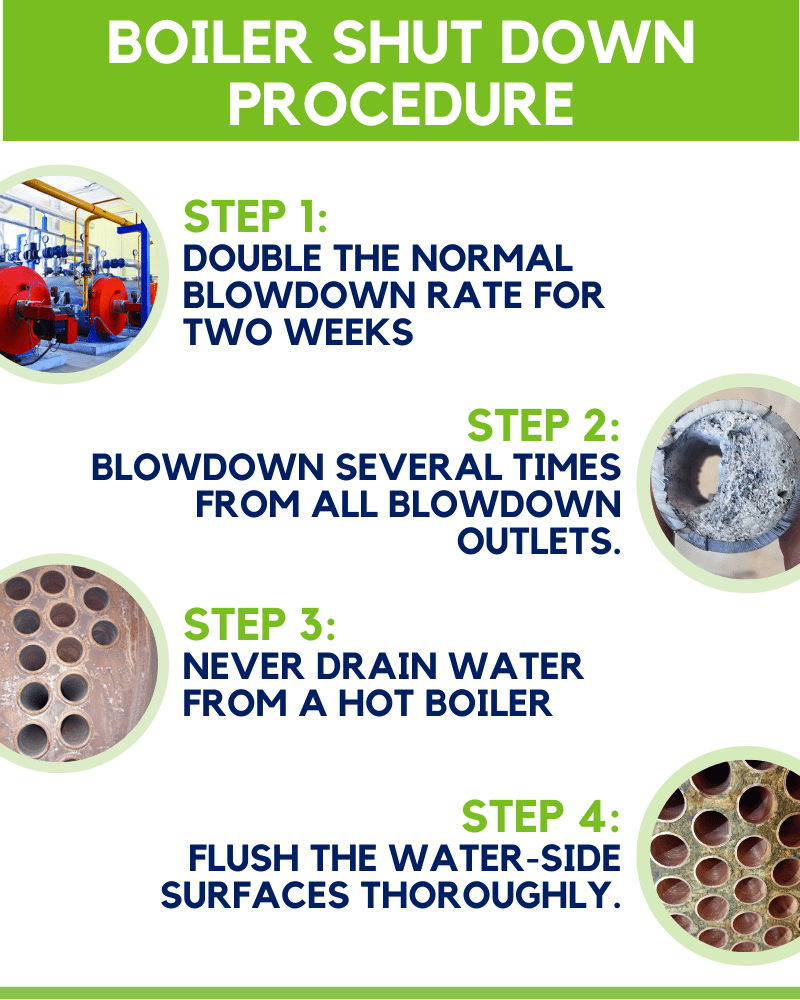How to Properly Shut Down a Boiler
How to Shut Down a Boiler
Boiler shutdown is a critical process that, if done incorrectly, can lead to warping, corrosion, leaks, and costly repairs. Many boiler failures occur due to improper lay-up procedures, exposing internal components to moisture and oxygen, which accelerates corrosion.
To prevent damage, boilers should be shut down using the correct method and protected during idle periods. This guide provides step-by-step boiler shutdown procedures for wet and dry storage to help reduce downtime and extend equipment life.
How to Shut Down a Boiler: Step-by-Step Guide
1. Pre-Shutdown Preparation
- Increase blowdown rate to twice the normal amount for two weeks before the shutdown.
- Increase sludge conditioner dosage to 1.5 to 2 times normal levels.
2. Proper Shutdown Process
- Perform multiple blowdowns from all outlets, including headers.
- Refill with hot, deaerated feedwater to prevent oxygen exposure.
- Never use cold water for cooling, as it can cause leaks and strain in tube joints.
- Drain the boiler only when it has cooled sufficiently to prevent sludge from baking onto tubes.
- Flush water-side surfaces with a high-pressure hose to remove any remaining deposits.
- Clean fireside surfaces to remove soot and slag, as these can cause severe corrosion.
Boiler Storage Options
Boilers should be properly stored when out of service to prevent corrosion and system degradation. There are two main methods for boiler lay-up:
1. Dry Lay-Up (For Long-Term Storage)
This method removes moisture from the boiler and prevents tube wear and corrosion.
Dry Lay-Up Procedures
- Drain the boiler completely after it has cooled.
- Flush and inspect to ensure no residual sludge is left inside.
- Use warm, circulated air to thoroughly dry internal surfaces.
- Place quicklime or silica gel trays inside the boiler to absorb residual moisture.
- Seal all openings tightly to prevent air and moisture intrusion.
- Inspect every two months and replace moisture-absorbing materials as needed.
2. Wet Lay-Up (For Short-Term Storage)
The wet method fills the boiler with treated water, preventing oxygen contact and corrosion.
Wet Lay-Up Procedure
- Before shutting down, add boiler treatment chemicals like:
- BOILER AID 385: Tannin-based treatment to prevent corrosion.
- BOILER AID 386: Reducing agent to combat oxygen pitting.
- Fill the boiler completely with treated water to eliminate air pockets.
- Maintain a slight positive pressure (5 psig) of nitrogen to prevent air entry.
- Regularly test water quality and adjust chemicals as needed.
Returning an Idle Boiler to Service
Dry Storage Boilers
- Remove all moisture-absorbing chemicals before restarting.
- Check for any residual debris and clean if necessary.
Wet Storage Boilers
- Partially drain and refill with fresh feedwater to dilute excess treatment chemicals.
- If superheaters were stored wet, drain them before startup to prevent water hammer damage.
What Boiler Products Should You Use?
For boiler treatment, we recommend our Boiler Aid series, which contains a blend of:
✅ Complex polyphosphates for scale control
✅ Dispersants to keep surfaces clean
✅ Sludge conditioners to enhance removal
Top Recommended Products:
- Boiler Aid 385: A highly concentrated tannin-based steam boiler treatment for long-term corrosion prevention.
- Boiler Aid 386: A reducing agent that neutralizes oxygen, preventing pitting corrosion in boilers.
🔹 Explore ChemREADY Boiler Treatment Solutions
The ChemREADY Advantage
At ChemREADY, we provide comprehensive boiler water treatment solutions to extend boiler life, reduce corrosion, and improve efficiency. Our services include:
✅ Site surveys for system evaluation
✅ Total Service Management for boiler maintenance
✅ Custom boiler treatment programs
✅ Expert recommendations for boiler shutdown and lay-up procedures
🔹 Learn More: ChemREADY Boiler Water Treatment Services
FAQs About Boiler Shutdown
1. Why is it important to shut down a boiler properly?
Improper shutdown can cause warping, leaks, scale buildup, and corrosion, leading to expensive repairs and system failures.
2. What is the best way to store a boiler long-term?
The dry lay-up method is best for long-term storage, while the wet lay-up method is better for short-term storage when quick startup is needed.
3. How do I prevent boiler corrosion during shutdown?
Use oxygen scavengers like BOILER AID 385 or 386, keep the boiler completely dry or filled with treated water, and seal all openings to prevent moisture intrusion.
4. How often should I inspect an idle boiler?
For dry storage, inspect every two months. For wet storage, test water quality every one to two weeks.
5. How can ChemREADY help with boiler maintenance?
We offer site surveys, customized boiler treatment solutions, and total service management programs to ensure optimal boiler performance.
About The Author
Nick Piskura is the Marketing and Web Development Specialist at ChemREADY who utilizes expertise in digital marketing strategies to provide knowledgeable insights in each segment of our business. Nick provides insights through web development and multimedia resources that support ChemREADY’s full range of services, including Legionella management, ANSI/AAMI ST108 compliance, boiler and cooling tower treatment, wastewater processing, and industrial water quality solutions.

